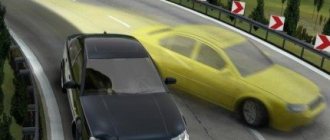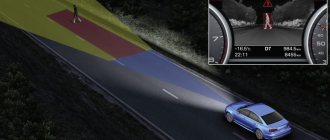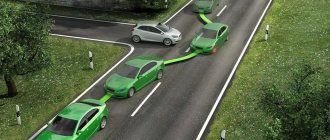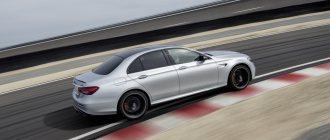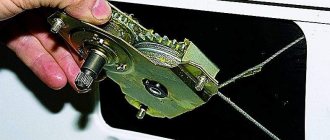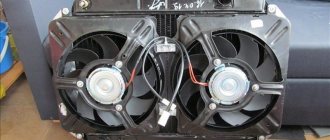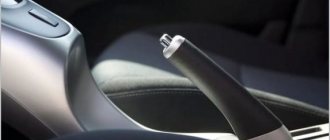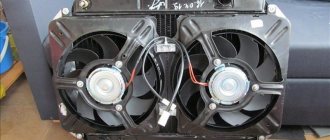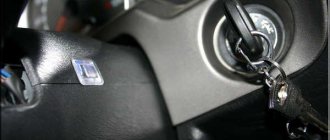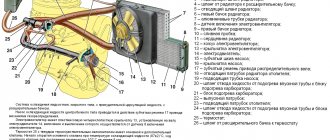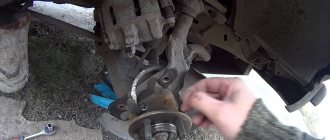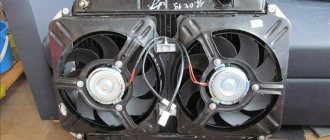The traction control system is a set of mechanisms and electronic components of a car that are designed to prevent slipping of the drive wheels. The TCS system (Traction Control System) is the trade name for a traction control system that is installed on Honda vehicles. Similar systems are installed on cars of other brands, but they have different trade names: TRC traction control system (Toyota), ASR traction control system (Audi, Mercedes, Volkswagen), ETC system (Range Rover) and others.
Activated TCS prevents the vehicle's drive wheels from slipping when starting out, sharp acceleration, cornering, poor road conditions and rapid lane changes. Let's consider the principle of operation of TCS, its components and general structure, as well as the pros and cons of its operation.
Working principle of TCS
The principle of operation of the traction control system The
general principle of operation of the Traction Control System is quite simple: the sensors included in the system record the position of the wheels, their angular speed and the degree of slippage. As soon as one of the wheels begins to slip, TCS instantly eliminates the loss of traction.
The traction control system copes with slippage in the following ways:
- Braking of slipping wheels. The braking system is activated at low speeds – up to 80 km/h.
- Reducing car engine torque. At speeds above 80 km/h, the engine management system is activated, which changes the amount of torque.
- A combination of the first two methods.
Note that the Traction Control System is installed on cars with an anti-lock braking system (ABS - Antilock Brake System). Both systems use the readings of the same sensors in their work; both systems have the goal of providing the wheels with maximum grip on the supporting surface. The main difference is that ABS limits wheel braking, while TCS, on the contrary, slows down a rapidly rotating wheel.
Traction control system ESP
A traction control system such as ESP deserves special attention. It is responsible for the directional stability of the car, preventing it from lateral sliding, skidding and rotation. If ABS works during braking, TRS and ASR during acceleration, then ESP works when turning and performing maneuvers. In fact, these elements of monitoring the current behavior of the machine create, if not completely safe, then conditions as close as possible to this.
During operation, ESP compares the driving direction specified by the driver with the actual one. All control is carried out based on signals from sensors dozens of times per second, practically the car is constantly under electronic control. If there is a discrepancy between the specified and actual direction of movement, i.e. sliding or skidding begins, ESP takes the necessary measures to eliminate it in a split second.
To do this, the traction control system reduces the speed of the car and applies the brakes to the necessary wheels, returning the car to the specified direction of travel.
Whether it is TCS or any other traction control system, they ensure the safety of the car and are used by their manufacturers more and more widely in cars of various classes. This approach allows many drivers, including experienced ones, to avoid critical situations when driving a vehicle.
What else is worth reading
Designation of winter tires
Anti-lock braking system abs
Electromagnetic car suspension
E class cars
How cruise control works
Device and main components
The ABS+TCS
Traction Control System design is based on elements of the anti-lock braking system. The wheel spin control system uses an electronic differential lock as well as an engine torque management system. The main components required to implement the functions of the TCS traction control system:
- Brake fluid pump. This component creates pressure in the vehicle's brake system.
- Switching solenoid valve and high pressure solenoid valve. Each drive wheel is equipped with such valves. These components control braking within a specified loop. Both valves are part of the ABS hydraulic unit.
- ABS/TCS control unit. Controls the traction control system using built-in software.
- The engine control unit. Interacts with the ABS/TCS control unit. The traction control system puts it into operation if the vehicle speed is more than 80 km/h. The engine control system receives data from sensors and sends control signals to actuators.
- Wheel speed sensors. Each wheel of the car is equipped with this sensor. The sensors record the rotation speed and then transmit signals to the ABS/TCS control unit.
TCS on/off button
Note that the driver can disable the traction control system. Usually there is a “TCS” button on the dashboard that turns the system on/off. Disabling TCS is accompanied by the illumination of the “TCS Off” indicator on the instrument panel. If such a button is missing, the traction control system can be turned off by removing the corresponding fuse. However, this is not recommended.
Inexpensive but effective disinfection of car air conditioning
- on Lada Vesta;
- Lada X Ray;
- Skoda Rapid;
- Skoda Octavia;
- Hyundai Solaris;
- Nissan Qashqai;
- Ford Eco Sport;
- Mitsubishi Lancer;
- Mercedes C class;
- BMW 3 Series;
- Audi A5;
- Renault Arcana, etc.
Moreover, in some cases, motorists are not even aware of its presence. There are also those who specifically disable the assistant with their own hands. There are even special videos on how to do this.
Now I’ll tell you a little about how ASR and similar systems work in practice, what happens to the car at this moment and what changes occur when the electronic assistant is activated.
The process is indeed not simple, but the driver has nothing to do with its implementation. The electronics operate themselves and set the actuators in motion automatically.
The operation of the system can be described something like this:
Advantages and disadvantages
Main advantages of Traction Control System:
- confident car start from a standstill on any road surface;
- vehicle stability when cornering;
- traffic safety in various weather conditions (ice, wet surfaces, snow);
- reduced tire wear.
Note that in some driving modes, the traction control system reduces engine performance and also does not allow full control of the vehicle’s behavior on the road.
Transporting a snowmobile: choosing the most convenient way
There are several main advantages that perfectly characterize the capabilities of the system in question.
These are good reasons to make such an assistant a mandatory element of the equipment of a modern car already in the basic factory configuration. It allows:
Application
The TCS traction control system is installed on cars of the Japanese brand “Honda”. Similar systems are installed on cars of other automakers, and the difference in trade names is explained by the fact that each automaker, independently of the others, developed a traction control system for its own needs.
The widespread use of this system has significantly increased the level of vehicle safety when driving due to continuous control of adhesion to the road surface and improved controllability when accelerating.
Only for experienced drivers
There is an opinion that traction control technology does not always please experienced drivers who like to independently control the car in all situations. In addition, it generally interferes with fans of extreme driving - you won’t burn the tires, you won’t be able to take turns effectively, so the question often arises: “How to disable ASR?”
In fact, there is nothing simpler - there is a special button that temporarily deactivates the traction control system, and a warning light on the instrument panel will remind you that it is turned off.
In conclusion, I would like to say that you should not neglect the electronics in your car, no matter how experienced a driver you are.
Is it possible to turn it off?
Since the anti-skid system installed on new cars always works, this annoys some drivers. They believe that automakers are depriving them of the opportunity to experience the drive that so-called extreme driving gives. In addition, any mechanism can break down - and this usually happens in extremely inconvenient situations - and the skills of safe driving without this electronic assistant will certainly come in handy. After all, sometimes you want to “prance” on deserted sections of country roads with potholes and potholes...
In many cars, the traction control switch is located on the dashboard, but sometimes it is located near the gear lever. When the ACP is deactivated, the corresponding diode on the instrument panel lights up. The driver's action algorithm depends on the make and model of the car. In expensive foreign cars, the shutdown occurs on the car's on-board computer - you just need to select the desired item from the software menu. And if the machine is simpler, then more complex manipulations will be required.
For example, on a Volkswagen Jetta you need to turn on the ignition and press the emergency stop button, then press the gas 5 times. When the “Slippery road” light on the instrument panel lights up, you can start the engine, deactivate the hazard warning lights and start.
The main task of ABS
Thanks to this system, the car's wheels are not blocked and the driver will be able to control it even by pressing the brake pedal to the floor. A car with working ABS reacts to turning the steering wheel, albeit with some delay. This way you can avoid an accident or minimize its consequences, and at the same time reduce your speed and dodge obstacles.
Let’s imagine someone suddenly brakes in front of the driver. A car without ABS will coast straight ahead, no matter how much the driver turns the steering wheel. A car with ABS can be somehow controlled, and most importantly, the braking distance will be much shorter, which means there will be a greater chance of not catching up with someone else’s car. Even if this happens, the damage will be less critical and you will be able to pay much less for repairs.
But in some cases, the braking distance of a car with ABS may be longer. For example, if the car has summer tires in winter, if there is sand, earth or unrolled snow under the wheels.
When you turn the ignition key, all warning lamps come on, and one of them is the ABS lamp. If it does not go out after starting the engine, the system is faulty, you must urgently make an appointment for diagnostics
Types of modern APS
Each automaker installs its own security systems on its cars. Because of this, for example, only APS has several names with different abbreviations:
- ASR – installed on Mercedes, Audi, Volkswagen cars;
- DSA - used exclusively for Opel cars;
- ASC - used on all BMW cars;
- TRC – installed on Toyotas;
- TCS is our own development.
Alternative names
Most often, the abbreviation ASR is found in different materials.
But this is far from the only name for traction control. This is due to the fact that each auto company strives to highlight its product, and therefore calls almost identical developments by different names.
In particular, you can find the following options:
- Mercedes, Audi and Volkswagen have ASR;
- the Bavarians from BMW use the concept of ASC;
- on Toyota cars it is TRC or A-TRAC;
- on Opel cars you will see the DSA icon;
- for elite crossovers Range Rover ETC;
- Swedish Volvos have the abbreviation STC;
- The Japanese from Honda use the concept of TCS.
But the most important thing here is that the name does not change the essence. The design and principle of operation are almost identical everywhere, but with their own small nuances that do not globally affect the operation of the system.
This is interesting: How often should you change the timing belt?
What is the danger of wheel locking when braking?
If the driver presses the pedal hard enough, then the braking force is enough to completely lock the wheels: the car will “skid” - the wheels will stop, and the car will continue to move by inertia. Bright black marks will remain on the asphalt, local wear will appear on the tires: they can suffer greatly and even become unusable. Imagine how an eraser wears out - almost the same thing will happen to a tire.
If the driver continues to press the brakes, sooner or later he will completely lose control of the car. With the front wheels locked, it will not be possible to change the trajectory of movement, even if you turn the steering wheel all the way. This situation is dangerous for both the driver and other road users. The ABS system combats precisely this phenomenon: it prevents the wheels from locking during braking and allows you to maintain control over the car during emergency braking.
NEW COURSE
BAS - emergency braking assistant
Brake Assist System is an emergency braking assistant. Other names for this system are VA, EVA. The principle of operation is the same - the system helps the driver to quickly brake to a complete stop .
BAS comes to the aid of drivers when, in an emergency, they press the brake pedal quickly but not hard enough.
The emergency braking assistant works like this: there is a sensor on the brake pedal that detects the speed of pressing. When the system assesses that the driver is trying to brake urgently, but is afraid to press the pedal to the floor, the hydraulic brake booster is activated , which adds force to pressing the pedal. As a result, the braking distance is reduced.
DBC, the Dynamic Brake Control system, works in a similar way. With DBC, it is possible to achieve effective emergency braking, even if the driver does not press the pedal optimally.
How does it work
The main function of anti-skid is to stop the free rotation of the wheel. To understand how the anti-skid system works in a car, you need to know what it consists of. This is a control unit and sensors that determine:
- angular acceleration of the driving wheels;
- vehicle speed (calculated from the angular speed of the non-driving wheels);
- features of the trajectory (curvilinear or straight);
- the amount of slippage (the electronics independently calculates the difference between the angular speed of the driving and non-driving wheels).
How does antibux work?
Based on the data received, the anti-skid control unit located in the car adjusts the braking force on the wheel and the torque transmitted from the engine. As a result, the car quickly stabilizes and begins to drive smoothly and smoothly.
Antibuks and brake pressure
In total, the braking system has three cycles:
- increase in brake fluid pressure;
- its retention;
- reset
During the first phase, the brake pads are pressed against the active wheel disk and braking occurs. Pressure is pumped into the hydraulic system using a special fast-running return pump. In this case, the switching valve closes and the inlet valve opens. Pressure is maintained when this device is turned off. Reset occurs when the release and changeover valve is opened. This happens only after the slipping stops. If necessary, the cycle can be repeated an unlimited number of times.
Antibux and torque
Antibuks controls torque when interacting with the engine. Information about the nature of movement is transmitted to the control unit, and the electronics determines the amount of torque. To do this, you need to know about the slippage of the drive wheels, their rotation speed and the speed of the vehicle. The required torque can be obtained using:
- movement of the throttle valve;
- regulating the volume of fuel injection or skipping injections;
- adjusting the advance angle in the ignition system;
- missing ignition pulses;
- canceling gear shifting - in cars with automatic transmission.
Traction control icon on the car panel
Immediately after activating the traction control system, the corresponding light on the instrument panel will light up. The driver will receive a signal that the car is currently in a difficult situation and the electronic system is trying to stabilize its position and avoid a dangerous situation.
1) Drift, quick start
If you are a racing driver, like to drift your car, or don't want the stability control system to interfere with your car's handling, you should turn off ESP. Otherwise, the system will prevent you from drifting when the car's wheels begin to lose traction. If you do not turn off ESP, the system will limit wheel slip not only by braking the wheels, but also reduce the transmission of torque to them.
Does ASR protect the automatic transmission?
The operation of the traction control system has an extremely positive effect on the automatic transmission. Although it is also useful on cars with “mechanics”. Firstly, ASR is configured in such a way as to help the driver get out of a skid as much as possible and not slip. And, as you know, slipping of the drive wheels leads to strong heating of the oil in the automatic transmission, which shortens the operating period of this expensive unit. Suffice it to say that literally one prolonged slip can damage all gearbox solenoids.
In addition, we must not forget about sudden starts, which reduce the working life of the torque converter by an order of magnitude. Therefore, the ability to “strangle” the wheels is a very useful option in the list of traction control functions.
Best driving instructors:
- Driving instructor IrinaAutomatic: Kia CeratoTrains in SZAO, ZAO
REVIEWS
Driving instructor Natalya Automatic transmission: Kia Spectra Teaches in the Eastern Administrative District, Balashikha, Reutov
REVIEWS
Driving instructor Olga Automatic transmission: Kia Spectra Manual transmission: Chevrolet Lanos Trains in the Southern Administrative District, South-Western Administrative District, South-Eastern Administrative District, Vidnoye
REVIEWS
Driving instructor Yana Automatic transmission: Kia Spectra Trains in Northern Administrative Okrug, Dolgoprudny
REVIEWS
Driving instructor Yulia Automatic transmission: Chevrolet Lacetti Manual transmission: Chevrolet Lanos Trains in the Eastern Administrative District, South-East Administrative District, Lyubertsy, Reutov, Zheleznodorozhny
REVIEWS
Automotive instructor Svetlana Automatic transmission: Chevrolet Lacetti Trains in Northwestern Administrative District
REVIEWS
Driving instructor Tatyana Manual transmission: Chevrolet Lanos Automatic transmission: Kia Spectr Trains in Krasnogorsk
REVIEWS
Automotive instructor Peter Manual: Daewoo Nexia Trains in Northwestern Administrative District
REVIEWS
Driving instructor Oksana Automatic transmission: Hyundai Accent Manual transmission: Chevrolet Lanos Trains in North-Eastern Administrative District, Mytishchi, Korolev, Pushkin
REVIEWS
Driving instructor Dmitry Automatic transmission: Volkswagen Golf Manual transmission: Chevrolet Lanos Trains in North-East Administrative District, Northern Administrative District, North-Western Administrative District, Dolgoprudny
REVIEWS
Driving instructor Oksana Automatic transmission: Kia Spectra Manual transmission: Chevrolet Lanos Trains in the Southern Administrative District, South-Western Administrative District, Vidnoye, Podolsk
REVIEWS
Driving instructor Ekaterina Automatic transmission: Hyundai Accent Manual transmission: Daewoo Nexia Trains in North-Western Administrative District, Northern Administrative District, Khimki, Dolgoprudny
REVIEWS
Automotive instructor Dmitry Manual transmission: Lada Granta Trains in the South-Eastern Administrative District, Lyubertsy
REVIEWS
Search the site Autoinstructor199
Driving training exercises
Latest video tutorials:
Lesson dated 02/18/2020 on automatic transmission. Pyalovsky route, turns. Driving instructor Dmitry
Lesson dated 02/11/2020 on manual transmission. Lobnensky route, snowy road. Driving instructor Alina
Find an instructor
by districts of Moscow:
in the Moscow region:
Latest publications:
What to do if you break a tire on the road
Causes of squeaking in the front suspension when driving, braking and turning
Do-it-yourself headlight polishing. Basic polishing methods
How to quickly clean spark plugs from carbon deposits
Signs of DTOZH malfunction
How to quickly replace a damaged wheel
